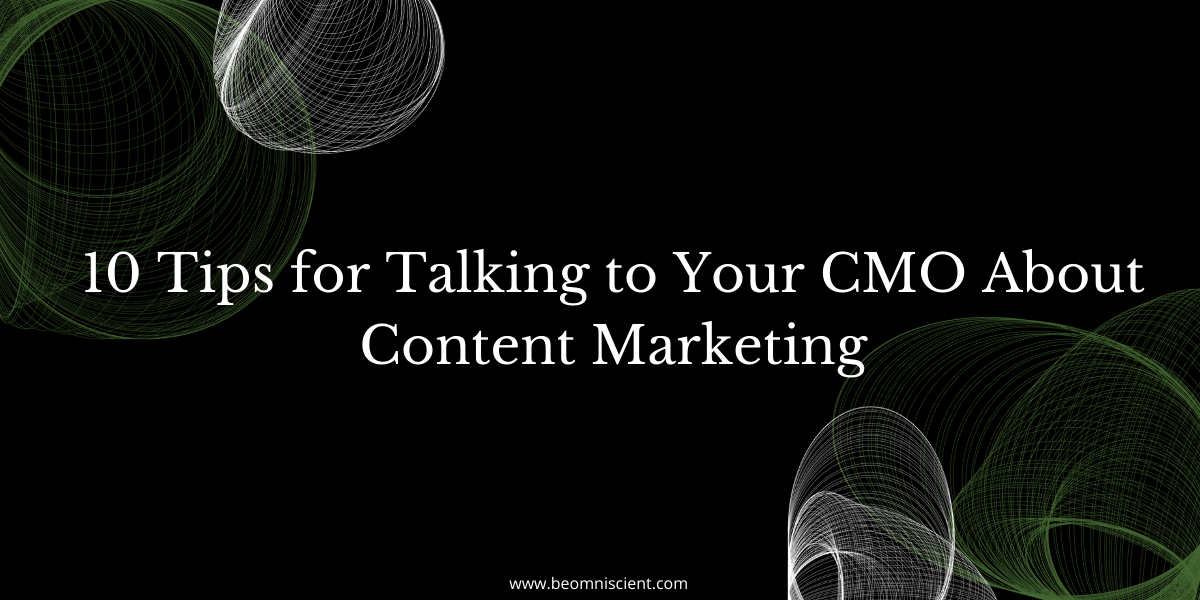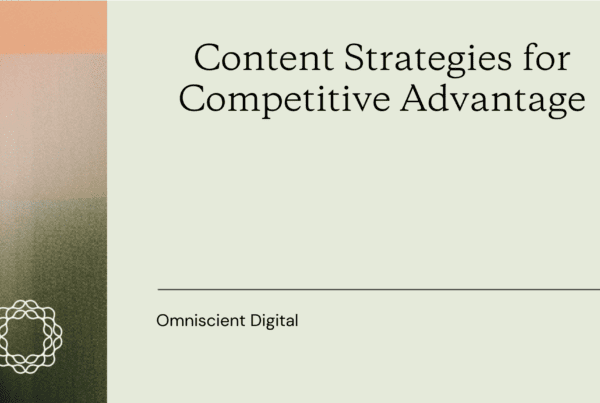
Heads of content and content strategists have to work with their CMO on a variety of things to get their job done.
The challenge is showing the CMO the value of content marketing in order to get what you need.
Depending on the size of the organization, you may need buy-in for strategy. This involves things like building bridges with sales, customer service, and product teams, and getting budget approval for new employees and software.
Any missteps can hurt your ability to succeed at your job.
Omniscient’s Alex, Allie, and David came up with 10 tips for talking to your CMO that will make it easier to get what you need – and create a stronger relationship in the process.
1. Show the numbers
CMOs are executives, and every executive wants to see the numbers.
When developing a content strategy, first identify opportunities for growth. Next, summarize what could happen if you invested in those opportunities.
Finally, work backwards to figure out what you need to get there.
“I think that’s something that speaks to an executive position, because they frankly, in many cases, don’t care how it gets done,” Alex said. “But if you prove if it’s done this way, that we get these results, that’s the language that they’re going to speak.”
Your CMO probably already believes in the power of content marketing, but they may not know what all goes into achieving results with it.
Show them the process and the numbers and they’ll be more likely to buy in.
2. Speak to business goals
A CMO is held to metrics, so they will hold you to them, too.
Make sure that whatever strategy you develop is tied to larger business goals.
“Whether it’s generating leads for a sales team or getting X number of users for your free product,” David said, “it’s the job of the head of content or director of content to have that goal in mind and say, here’s how content contributes to that.”
Model out how your approach will help the company with its wider business strategy. Don’t just create content for the sake of content.
“Knowing what the CMO cares about and figuring out how your job contributes to that is 1), how you keep your job, but 2), how you make the content strategy,” David said.
3. Think creatively to fill gaps
If your company already has a content strategy in place, look to see what types of content are missing or find ways to level up the existing process.
When Allie was at HubSpot, she realized that although they were creating a lot of SEO-driven content, they were outsourcing for experts when they could be looking internally.
“Here I was, a pretty young writer with some firsthand business experience, and I was researching things written by other companies. Stats, experience stories, opinions that these other publications and other things online, just as valid, but they were sharing them with me. And I was linking back to them and I was sourcing them,” Allie said.
“And I was like, aren’t there people at HubSpot that do this themselves?”
She started building a thought leadership program using their own marketing, sales, and customer teams as subject matter experts.
It was not only a way to gain more knowledge on what she was writing, but to promote HubSpot’s authority on those subjects.
4. Promote what you own
When building a content strategy, find ways to promote the expertise your company owns.
David used the company Drift as an example.
“They turned conversational marketing into its own, they created that category,” David said. “There was no organic search behind conversational marketing. They’re like, we don’t care. We want to own this. And we want people to talk about it in a way that we talk about it.”
That type of brand position would come from a CMO, and as a content lead, you could align your strategy to support that.
5. Play by the rules, but diverge from the expected
If you have an idea that doesn’t yet have buy-in from the CMO, there are ways to gradually prove its worth.
Allie built the HubSpot thought leadership program in that way.
“You played within the rules,” Alex said. “You did your work in terms of what people expected, but then you started to diverge a little bit and you started to incorporate some of the stuff you wanted to do.”
Once people start to like it, you can get that buy-in progressively.
“It started out at this very small level where you just sort of took the initiative and it was sort of, ask forgiveness, not permission,” Alex said. “Then you took those results and parlayed those into more and more excitement for it.”
That excitement can snowball and position it so that you can ask for a bigger investment.
6. Look at program sustainability
The content programs you create may be exciting, but may not be sustainable in the long run for the company’s goals.
Allie learned that from her time at HubSpot.
The company eventually turned her thought leadership program into what they call hybrid content, which marries thought leadership with SEO.
“I took mine in more of a, ‘I’m going to start with the author and go from there,’” Allie said. “And they started with the strategy and went from there. I would say the latter is probably a more sustainable thing, especially if organic is something that your CMO believes in.”
Allie has since come up with an approach she calls the ‘SEO sandwich’ that is more sustainable.
She starts with SEO research and strategy, then writes the piece using her own expertise and that from subject matter experts in the organization, then optimizes it using SEO tools.
“I personally believe that’s the best way to create content, and it’s the best way to avoid having duplicate after duplicate on Google,” Allie said.
7. When things don’t line up, create a new mindset
Sometimes you and your CMO won’t see eye to eye on what’s the best content strategy for the company.
Maybe they believe in organic and you don’t, or vice versa. Don’t think the only answer is to leave.
“You do your research, you spend a month or two understanding what some other channels might be,” Allie said.
“Maybe you dabble a bit, experiment. If it’s something that’s already entrenched in the company, it’s going to take just as much work, if not more, to create a whole new mindset around something kind of like an unlearning.”
If your idea isn’t a passion project, you may need to let it go.
It is something you’re passionate about though, find ways to create support like a dedicated newsletter or working with the social team.
8. Play the long game of building trust
It’s inevitable that you’ll have ideas that don’t fit the mold of the company you’re in. That’s the life of a creative and interesting thinker.
But before you try to get buy-in for your big ideas, you have to build trust.
“You actually have to play by the rules and get things done and get results first,” Alex said. “And then you sort of build allies and you build stakeholder relationships and you get other teams interested too.”
Slowly scale your experiments. Don’t rock the boat too soon.
“I think it’s like the bigger and riskier the initiative and the staunch or more idiosyncratic the CMO, the longer it’s gonna take to do that,” Alex said.
Especially when you’re just starting out with a company, play the long game.
9. Get humble for headcount requests
One of the harder requests to make of your CMO is budget approval for hiring more people.
Allie said it’s a humbling experience, but often necessary.
“I think it personally involves a lot of humility, especially if you’re a team of one,” Allie said. “I basically had to admit, I can’t do this alone and that’s okay.”
When creating content, you’ll often need help to make it the best it can be.
“You can’t just continue to churn out the highest quality,” Allie said. “And in my specific case, I wasn’t a subject matter expert on everything I wanted to create.”
Admitting that you need a freelancer or other help to reach your strategy goals is an effective way to talk about this with your CMO.
10. Get a read on the company culture
Looking to get buy-in for a new software tool, or make another change? Learn what’s incentivized at your company.
Some companies require proof of how your idea will work up front, others are open to experimenting.
“One of the first things you want to do is just observe how people make decisions and how people operate, what they’re goaled on and what they’re incentivized by,” Alex said.
Some companies incentivize action. Some encourage employees to market themselves, while others hate that.
“I think you want to know how people operate — how your boss does, how your boss’s boss does,” Alex said. “What makes them look good? How other teams around you are perceived, and how they’re incentivized.”
Figure this out in the first month to 90 days and then follow the lead.
When you embrace the company culture and come to your CMO with the right numbers, goals, and incentives in place, you’re setting yourself up for success.
You can think and work outside of the box, but always keep those things in mind.


